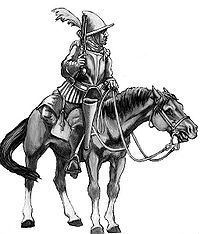 | ||
Similar | ||
Reiter s syndrome muscular skeletal diseases nclex rn khan academy
Reiters (German: Reiter, singular: German: Reiter, or horseriders, shortened from the original "Schwarze Reiter"—literally, "black riders" for the colour of their armour) were a type of cavalry which appeared in the armies of Western Europe in the 16th century in place of the outmoded lance-armed knights, at the same time that cuirassiers and dragoons began to attain typological distinction from other kinds of cavalry. The Reiters raised firearms to the status of primary weapons for cavalry, as opposed to earlier Western European heavy cavalry which primarily relied upon mêlée weapons.
Contents
- Reiter s syndrome muscular skeletal diseases nclex rn khan academy
- Reiter s syndrome everything you need to know dr nabil ebraheim
- In popular culture
- References
A Reiter's main weapons were two or more pistols and a sword; most Reiters wore helmets and cuirasses and often additional armor for the arms and legs; sometimes they also carried a long cavalry firearm known as an arquebus or a carbine (although this type of horsemen soon became regarded as a separate class of cavalry—the arquebusier or in Britain harquebusier).
In general, commanders expected Reiters to be able to engage their opponents both with firearms and with swords. In the 16th century and up to about 1620, Reiters often formed up in deep blocks and used their firearms in a caracole attack in the hopes of disordering enemy infantry before charging home and engaging in hand-to-hand combat. However, enterprising commanders such as Henry IV (died 1610) and Gustavus Adolphus (died 1632) preferred to employ their Reiters and other heavy cavalry in a more aggressive manner, ordering them to press the charge and fire their pistols at point-blank range (especially against well-armored enemies) or to use their swords instead. Using either or both of these tactics, Reiters could be incredibly effective when properly employed. A particular case in point is the Battle of Turnhout in 1597, where a force of Dutch Reiters under Maurice of Nassau defeated the opposing Spanish cavalry and then successfully engaged the Spanish infantry with a combination of pistol volleys and sword-in-hand charges.
The Reiters mostly consisted of Germans and served in the armies of the German states, in Sweden as "raitars", in Poland as Polish: "rajtaria", and elsewhere. Reiter regiments (Russian: рейтары, translit. reitary) also operated in Russian armies between the 1630s and the early 18th century (see Regiments of the new order).
In the later 17th century the Reiters gradually merged into generic cavalry regiments and were no longer seen as a distinct class of horseman.
Reiter s syndrome everything you need to know dr nabil ebraheim
In popular culture
Ruyters, a different spelling of Reiters, are used by the Dutch civilization in the strategy game Age of Empires III.
In the grand strategy game Europa Universalis IV, Schwarze Reiter is a selectable type of cavalry.
